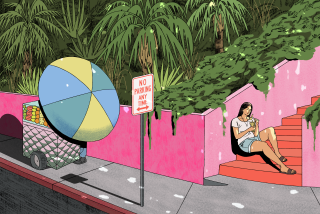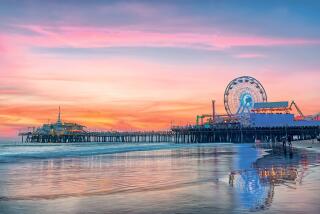In Need of a Moral Compass
LAKEWOOD — The deconstruction of the city of Los Angeles is turning out to be remarkably easy. It doesn’t require an apocalypse or even an act of will. It only takes acquiescence to the powerful centrifugal forces of race, class and utopian longing that have tugged at this city for more than 100 years. The moral order of Los Angeles, always a subject of doubt, seems incapable of resisting.
The moral order in the life of any city is the story of illustrative failure and heroism it passes on to its citizens. That story needs to be both familiar and believable. L.A.’s working poor, cocooned elites and secessionist suburbanites feel so uncomfortable together in their distrust of any shared story that they might actually forego being L.A.’s citizens. That’s remarkable in a city whose major industry is storytelling, except the Hollywood version of the L.A. story is mostly about consumption and almost never about citizenship.
It’s not an infallible guide that L.A. needs, only a more generous and inclusive conception of the common good than the official indifference that greeted stranded bus riders during the transit strike just ended. L.A. has shed one moral order (a disfiguring story of Anglo fears of immigrants and their politics) but seems incapable of finding another. Fortunately, the outlines of a new order may be forming far from the city’s traditional centers of authority.
Living in a city with no coherent narrative of its purpose has disturbing consequences for both public and private L.A.: It empowers separatist movements in the San Fernando Valley, San Pedro and Hollywood. It virtually requires some disassembly of the lumbering Los Angeles Unified School District. It contributes to the increase in the rate of the city’s violent crime (up 10% this year) and the drop in the number of arrests (down 23% this year). It silences frightened witnesses in gang-related murder cases and gives cover to the assassins of a cranky Venice activist who disputed with gang members the right to define the character of his neighborhood. It allows the Los Angeles Police Department to accommodate its infidelities shamelessly. It even propelled Mayor Richard Riordan to oppose a new state law making it harder to form nonunionized transit districts in the Valley and elsewhere. Eroding the paychecks of union transit workers justified the mayor’s unintended aid to suburban breakaway movements.
A city in so much haste to harm itself is without a moral compass. Its lack accelerates the rifting between the city’s working-class core and its affluent edges. The gap could be filled by immigrants eager to be in the middle if the city made more effort to make a place for them. But increasing disparities in wages, housing, child-care availability, health insurance coverage and even simple mobility steadily hollowed out L.A.’s aspiring middle during the late 1990s, even as unemployment dropped and the total number of jobs increased. The region’s 1 million working “almost poor” (broadly defined as a family of four making less than $33,300) work mostly without union benefits and with the handicaps of poor education, limited English skills and uncertain immigration status. They don’t work for the nimble “new economy” of dot-com individualists but for all the anonymous services that sustain it.
It is about these citizens that L.A.’s Marie Antoinettes muttered, “Let them drive Lexuses” during the transit strike, and Riordan praised for being so unexpectedly resilient, as if they had any other choice.
The L.A. people who, in Peter Schrag’s terms, are “more closely connected to their peers in New York or Tokyo, or Hong Kong or London, than they are to the people on the street below” presume to draw on common social capital, to which they make only ambiguous and tentative contributions. At worst, theirs is a “cocoon citizenship.” Even the secular faiths of politics and culture--traditional centers for defining a city’s moral order--seem to have abandoned their role in assuring the common good and substituted a loose federation of unrelated self-interest groups, each seeking primarily its own sovereign identity, for the idea of a city for everyone.
Whatever that idea is today, its clock is running out. By 2002, voters in the Valley and the city at large will test their appetite for secession. By 2003, the present cohort of the city’s elected officials will have been replaced or reshuffled by term limits. By 2004, the reform City Charter should have had enough time to redirect the flow of political power from the leaderless City Council, upward to the mayor’s office, and outward to the charter’s untested but hopeful network of area planning commissions and neighborhood councils.
The fluid substance of power at City Hall will remain cash, as it always has been, but it will come from the city’s labor unions and middle-size entrepreneurs, not from corporate bankers, insurance and petroleum executives, and plant managers of the Los Angeles that has passed away. Their city was always “south of the South” in its fear of backsliding into a “mongrel” society. The social landscape we’ve inherited, from the placement of the L.A. River in its current bed to the weird boundaries of our local governments, documents their struggle to define a white and largely middle-class metropolis in a working-class and mestizo countryside. The effort failed, except as a sales pitch. Failure this time to redefine L.A.’s moral order could end with no recognizable city at all.
It’s too early to tell if the reform charter is sufficient as both “civic technology” and bearer of communal identity to resist the dismemberment of Los Angeles.
It’s also too early to judge what communitarian values, if any, will transfer from the experiences of union members to an L.A. that is overwhelmingly nonunion. We’ll have to wait until next year--after a new mayor, city attorney, city controller, and eight members of the 15-member council are elected with the help of public-sector unions--to judge if centerless L.A. is ready to coalesce around policies aimed at immigration amnesty, a living wage and labor solidarity. At the moment, it’s not, if the outcome of the two public-sector strikes this fall is the measure of success. While L.A.’s unions have become better organized overall, and public-sector unions vastly more political, the abrupt end of the county workers’ walkout and the equivocal end of the long transit strike revealed more confusion than consensus about the impact of resurgent unions on the character of the city.
Yet, some centers in Los Angeles still hold, and it’s from them that a new narrative might be woven for a morally directionless city. The story will have to include more about us, what we find familiar and the justice we yearn for.
Restoration of the L.A. landscape is pulling together low-income neighborhoods, nonprofit organizations, like North East Trees and the Trust for Public Land, and middle-class volunteers. People who don’t rub shoulders on the street are working together to build new public places and the shared loyalties that go with them. Serving L.A.’s working poor has become a major industry of faith-based organizations and community self-help groups. (Of the 1,354 religiously affiliated nonprofit corporations in L.A. tracked by USC’s Center for Religion and Civic Culture, more than 500 were created by congregations to finance housing construction and human services.) Sunday may still be the most segregated day of the week, but the other days in L.A. are becoming filled with a common effort at community building.
Los Angeles succeeded once, less as a place and more as a manufactured product of astonishing attractiveness, rendered from almost nothing except sunshine, air, dirt and too little water. Of all its sales pitches, the one that earned consumer loyalty claimed that Los Angeles was the perfect refuge from ethnic multitudes and their big-city politics. This sounds like irony, but it isn’t. It’s the fate of L.A.--I almost said the grace of L.A.--to have finally become a big city, now that it’s stopped being mostly a roadside attraction. What once made L.A. exceptional--its unaccountable civic structure, its conception of power as only the means to more development, its working-class silence and its neutrality--leaves L.A. more commonplace when they are gone, and a better place for finding the common good.
Demographically, economically and politically, L.A. today is nearly a re-founded city, and like the experience of recently re-founded nations, Los Angeles can acquiesce to its flawed narratives or benefit from a shared process of “truth and reconciliation.” We have something to learn from each other in our uncomfortable civic education and a lot to forgive: the way L.A. looks, how it’s policed and why it is so willfully forgetful of the good that is already being done. Something genuine and encumbered could come from the process of remaking our moral order--a refigured story that contains a compass direction that we can trust.
More to Read
Sign up for Essential California
The most important California stories and recommendations in your inbox every morning.
You may occasionally receive promotional content from the Los Angeles Times.










